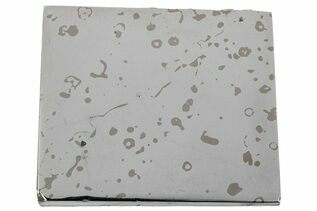MUNDRABILLA METEORITE FOR SALE
The Mundrabilla meteorite is a famous IAB (ungrouped) iron meteorite that fell in a remote area of Western Australia known as the Nullarbor Plain. It is one of the largest meteorites ever found: over 22 metric tons have been recovered since its discovery, and the main mass itself is over 12 tons!
Mundrabilla has a long history of findings, classifications, and reclassifications. The first pieces were found in 1911 while building a transcontinental railway route on the Nullarbor Plain. They were called Premier Downs I and II for the nearby station. More and more fragments, all of nearly identical composition, were found in the area until the two largest masses (12.4 and 5.4 metric tons, respectively) were discovered by geologists on a survey in 1966. They were about 200 meters apart, surrounded by numerous smaller iron fragments. These two main masses connected all the dots: upon study, most all of the smaller fragments found since 1911 were part of this larger meteorite, which was named Mundrabilla. The main mass, named Mundrabilla I, is the thirteenth-largest meteorite mass in the world. It is on display at the Western Australian Museum in Perth.
Mundrabilla is known for its interesting shapes and thumbprint-like regmaglypts, caused by parts of the meteorite melting away as it traveled through Earth’s atmosphere. It is about 65 to 75% iron-nickel by volume, and even contains a superconductive alloy of tin, lead, and the rare metal indium. Unless cleaned, all pieces have an orange patina.
The recovery site is now a protected area and collecting is forbidden. Any Mundrabilla material on the market is limited to old collection material.
Mundrabilla has a long history of findings, classifications, and reclassifications. The first pieces were found in 1911 while building a transcontinental railway route on the Nullarbor Plain. They were called Premier Downs I and II for the nearby station. More and more fragments, all of nearly identical composition, were found in the area until the two largest masses (12.4 and 5.4 metric tons, respectively) were discovered by geologists on a survey in 1966. They were about 200 meters apart, surrounded by numerous smaller iron fragments. These two main masses connected all the dots: upon study, most all of the smaller fragments found since 1911 were part of this larger meteorite, which was named Mundrabilla. The main mass, named Mundrabilla I, is the thirteenth-largest meteorite mass in the world. It is on display at the Western Australian Museum in Perth.
Mundrabilla is known for its interesting shapes and thumbprint-like regmaglypts, caused by parts of the meteorite melting away as it traveled through Earth’s atmosphere. It is about 65 to 75% iron-nickel by volume, and even contains a superconductive alloy of tin, lead, and the rare metal indium. Unless cleaned, all pieces have an orange patina.
The recovery site is now a protected area and collecting is forbidden. Any Mundrabilla material on the market is limited to old collection material.
3 Items
($59 to $85)
Related Categories

Iron Meteorites

Agoudal Meteorites

Balambala Iron Meteorite

Canyon Diablo Meteorites

Dronino Meteorites

Gebel Kamil Meteorites

Gibeon Meteorites

Sikhote-Alin Meteorites
 Reviews
Reviews



